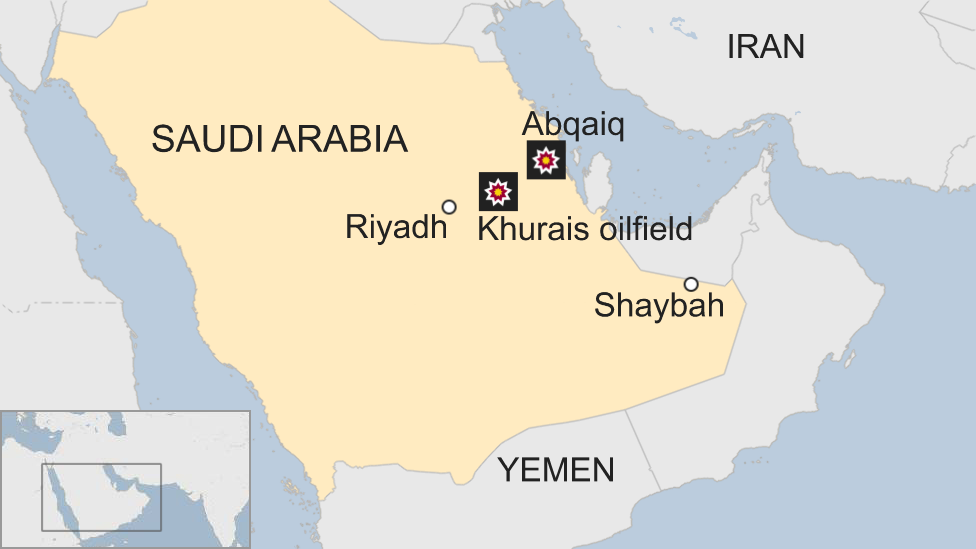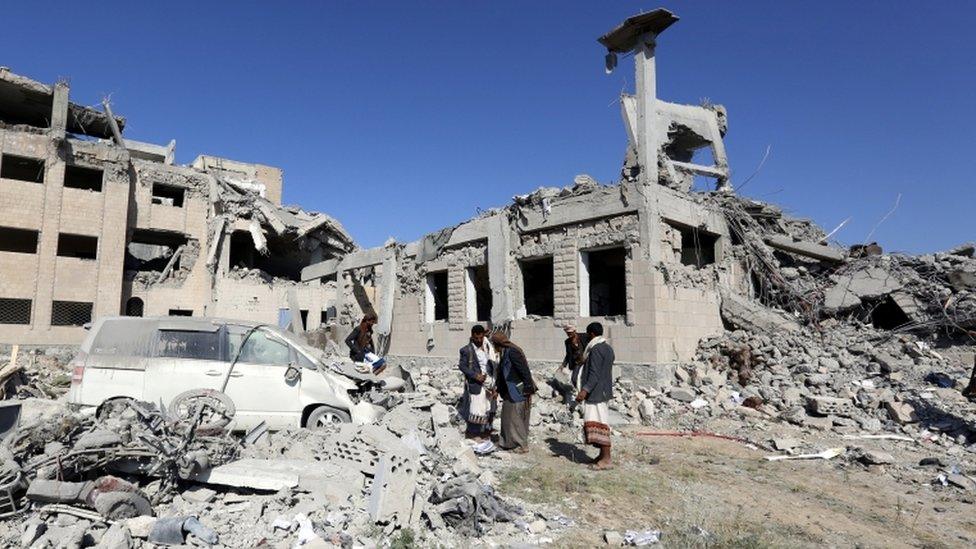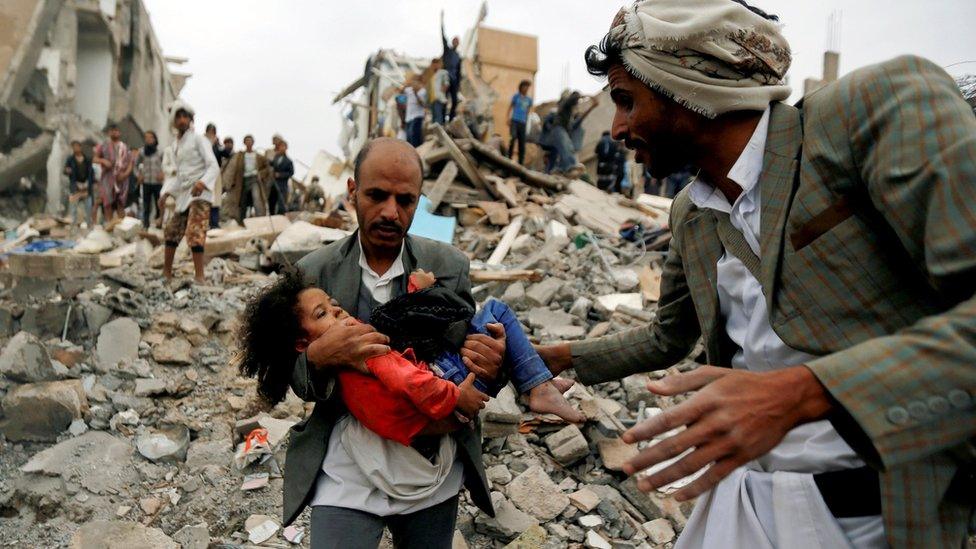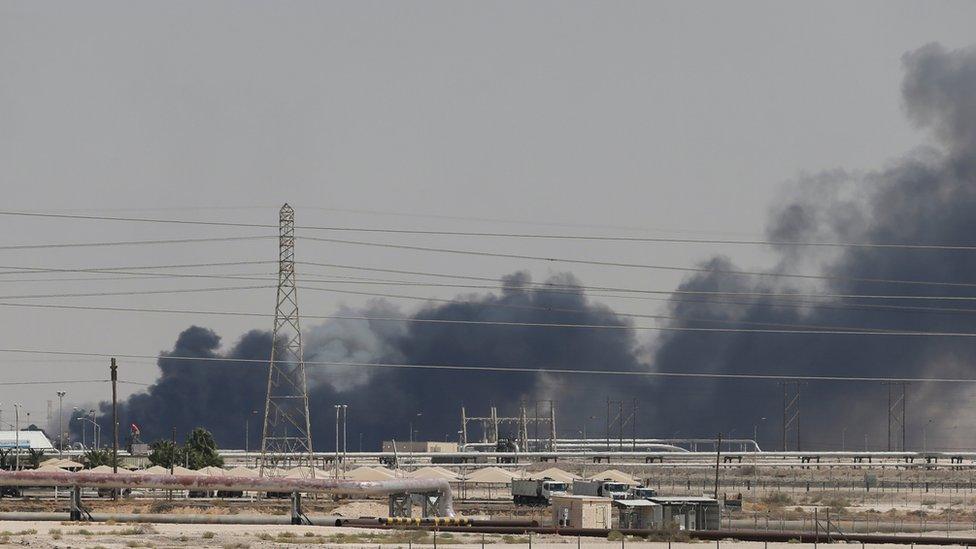Saudi oil attacks: US blames Iran for drone strikes on two sites
- Published
Abqaiq is the site of Aramco's largest oil processing plant
US Secretary of State Mike Pompeo has blamed Iran for Saturday's drone attacks on Saudi oil facilities.
He dismissed a claim by Yemen's Iran-backed Houthi rebels that they had attacked the two facilities, run by state-owned company Aramco.
Iran's foreign minister accused Mr Pompeo of "deceit".
Saudi Arabia's energy minister said the strikes had reduced crude oil production by 5.7 million barrels a day - about half the kingdom's output.
Correspondents say they could have a significant impact on world oil prices.
The main Saudi stock exchange plummeted 3% on opening on Sunday, before recovering.
Saturday's drone attacks hit Abqaiq, site of Aramco's largest oil processing plant, and the Khurais oilfield.

The Saudis lead a Western-backed military coalition supporting Yemen's government, in opposition to the Houthi rebel movement.
The attacks also come against a backdrop of continuing tension between the US and Iran, following US President Donald Trump's abandonment of a deal limiting Iran's nuclear activities and reinstatement of sanctions.
What did Mike Pompeo say?
In a tweet, he said there was "no evidence" the drones came from Yemen.
He described the attack as "an unprecedented attack on the world's energy supply".
Allow X content?
This article contains content provided by X. We ask for your permission before anything is loaded, as they may be using cookies and other technologies. You may want to read X’s cookie policy, external and privacy policy, external before accepting. To view this content choose ‘accept and continue’.

"We call on all nations to publicly and unequivocally condemn Iran's attacks," Mr Pompeo added.
The US would work with its allies to ensure energy markets remained well supplied and "Iran is held accountable for its aggression", he added.
The White House said Mr Trump had offered US support to help Saudi Arabia defend itself.
What is behind his allegations?
Mr Pompeo provided no specific evidence to back up his accusations.
They do follow a pattern of the US blaming Iran for recent attacks involving oil supplies in the region.

A Nasa satellite image shows smoke from fires following the drone attacks
The US said Iran was behind attacks on two oil tankers in the Gulf in June and July, as well as on another four in May. Tehran rejected the accusations in both cases.
If the rebels had deployed the drones from Yemen, they would have to have flown hundreds of miles.
One element of the Houthi statement on the attacks did however thank "co-operation with the honourable people inside the kingdom".
The Wall Street Journal has said experts are investigating whether the attacks could have been carried out from the north - either by Iran or its Shia allies in Iraq - using cruise missiles rather than drones. If so, it seems unlikely they would have escaped detection.
The BBC's Frank Gardner looks at the evidence the US says proves Iran's involvement in attacks on two tankers in June
The Washington Post said the US government believed that 15 buildings at Abqaiq had been damaged on the west-northwest sides, not the southern sides facing Yemen.
A 2018 UN report concluded that the Houthis' Qatef-1 suicide drone was "virtually identical" to Iran's Ababil-T. The Ababil-T is considered a low-tech drone with a maximum range of about 150km (93 miles).
The distance from the nearest point of the Saudi Arabia-Yemen border to the closest target - Khurais - is about 770km.
On Sunday, Iraq denied its territory had been used to launch the attacks.
How has Iran responded?
Foreign Minister Javad Zarif replied on Twitter, saying that "having failed at max pressure, Sec Pompeo's turning to max deceit".
He was referring to the Trump administration's stated "maximum pressure campaign" targeting the Iranian regime with sanctions.
Mr Zarif said that "blaming Iran won't end the disaster" in Yemen.
Earlier, foreign ministry spokesman Abbas Mousavi said that Mr Pompeo's "blind accusations and remarks are incomprehensible and meaningless".
Mr Mousavi said Saudi Arabia had "repeatedly violated Yemen" and that the "Yemenis have shown resistance to aggression".
What has Saudi Arabia said?
It has provided very little information from the two sites.
A spokesman for the Saudi-led military coalition fighting in Yemen said investigations were still ongoing to determine who had carried them out.
Officials have said there were no casualties.
Saudi state media reported that Saudi Crown Prince Mohammed bin Salman had told President Trump in a telephone conversation that the kingdom was "willing and able to confront and deal with this terrorist aggression".
The Tadawul All-Shares Index lost 200 points when it opened on Sunday, but had checked the 3% fall to about a 1% loss by midday.
What was in the Houthi statement?
A military spokesman said the rebels had deployed 10 drones in the attacks.
Yahya Sarea told al-Masirah TV, owned by the Houthi movement and based in Beirut, that operations against Saudi targets would "only grow wider and will be more painful than before, so long as their aggression and blockade continues".

Saudi-led coalition air strikes regularly target Houthis in Yemen
He said Saturday's attack was one of the biggest operations the Houthi forces had undertaken inside Saudi Arabia.
Yemen has been at war since 2015, when President Abdrabbuh Mansour Hadi was forced to flee the capital Sanaa by the Houthis. Saudi Arabia backs President Hadi, and has led a coalition of regional countries against the rebels.
The coalition launches air strikes almost every day, while the Houthis often fire missiles into Saudi Arabia.
Houthi fighters were blamed for drone attacks on the Shaybah natural gas liquefaction facility last month, and on other oil facilities in May.

Production cut could hit world prices
Analysis by BBC business correspondent Katie Prescott
Aramco is not only the world's biggest oil producer, it is also one of the world's most profitable businesses.
The Khurais oilfield produces about 1% of the world's oil, and Abqaiq is the company's largest facility - with the capacity to process 7% of the global supply. Even a brief or partial disruption could affect the company, and the oil supply, given their size.
There was a sharp intake of breath as analysts I spoke to digested the information that reports suggest that half of Saudi Arabia's oil production could have been knocked offline by these attacks.
The country produces 10% of the world's crude oil. Cutting this in half could have a significant effect on the oil price come Monday when markets open.
The success of the drone strike shows the vulnerability of Aramco's infrastructure, at a time when it is trying to show itself in its best light while gearing up to float on the stock market.
And it raises concerns that escalating tensions in the region could pose a broader risk to oil, potentially threatening the fifth of the world's supply that goes through the critical Strait of Hormuz.
- Published14 April 2023

- Published13 June 2018

- Published14 September 2019
